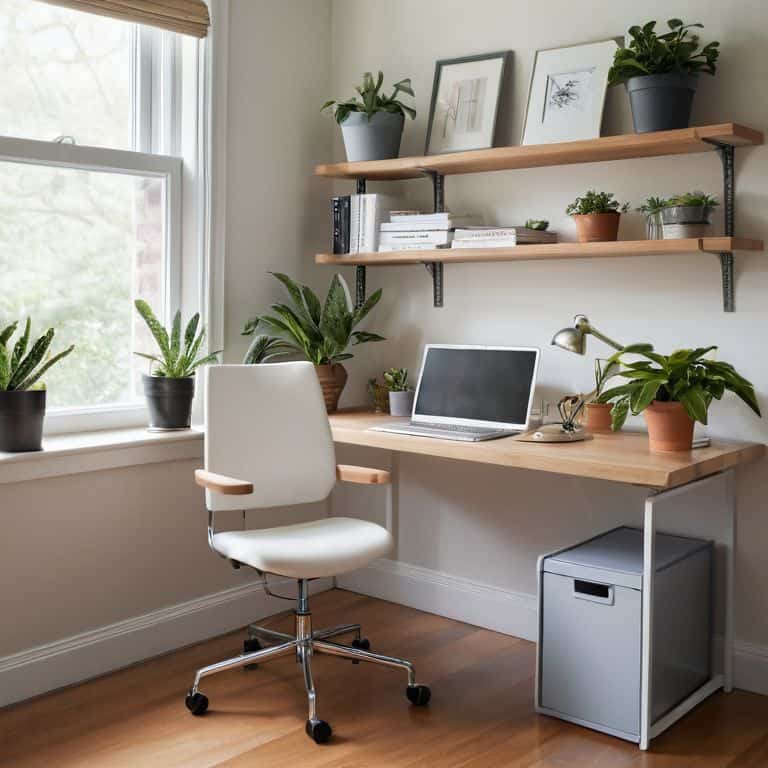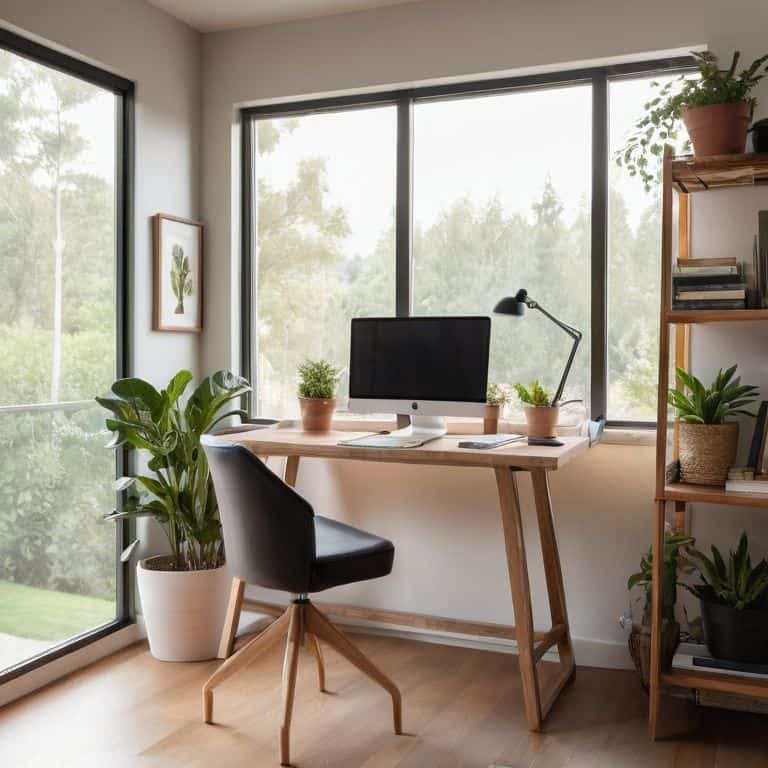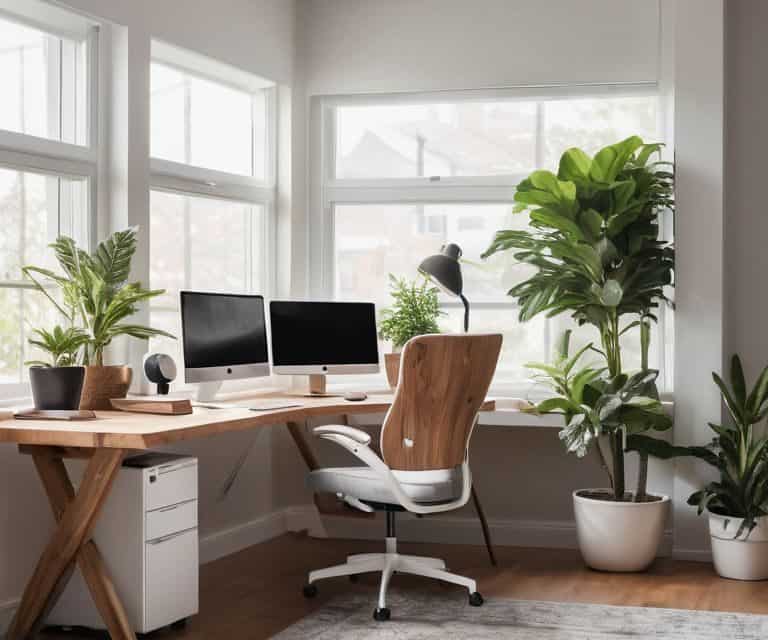I still remember the days when I thought working from home meant I could just plop myself down on the couch with my laptop and get to work. But after months of chronic back pain and eye strain, I realized that ergonomics for home office wasn’t just some fancy buzzword – it was a necessity. The truth is, most of us are guilty of neglecting our physical health when we work from home, and it’s time to debunk the myth that a comfortable workspace means sacrificing productivity.
As someone who’s been in your shoes, I want to assure you that creating a healthy and functional home office is within reach. In this article, I’ll share practical tips and actionable advice on how to set up your space to support your body and mind. You’ll learn how to choose the right furniture, optimize your lighting, and create a workflow that promotes productivity and reduces stress. My goal is to provide you with simple yet effective solutions to create an ergonomic home office that will transform the way you work and live.
Table of Contents
Guide Overview: What You'll Need

Total Time: 1 hour 30 minutes
Estimated Cost: $50 – $100
Difficulty Level: Easy
Tools Required
- Tape Measure for measuring workspace dimensions
- Level to ensure monitor and desk are level
- Wrench for adjusting chair height
Supplies & Materials
- Ergonomic Chair optional, but recommended
- Monitor Risers to achieve optimal monitor height, approximately 20 inches above desk surface
- Keyboard Tray to promote neutral wrist position, approximately 2 inches below desk surface
- Desk Lamp to reduce eye strain, with adjustable arm approximately 18 inches long
Step-by-Step Instructions
- 1. First, let’s start with the basics: assessing your current workspace. Take a good look around your home office and notice how you feel when you’re working. Are you hunched over your desk, or do you have to strain your eyes to see your screen? Make a mental note (or better yet, write it down) of any areas that feel uncomfortable or strained. This will help you identify what needs to be adjusted to create a more ergonomic setup.
- 2. Next, let’s talk about your chair. A good office chair can make all the difference in preventing back and neck pain. Look for a chair with adjustable height and lumbar support, and make sure it’s sturdy enough to support your weight. If you’re working with a budget, consider investing in a good chair rather than sacrificing your health for a cheaper option. Remember, this is an investment in your long-term wellness.
- 3. Now, let’s move on to your desk and computer setup. Ideally, your monitor should be at eye level or slightly below, and your keyboard and mouse should be positioned directly in front of you. Avoid reaching up or bending to type, as this can lead to repetitive strain injuries. Consider using a standing desk or a laptop stand to create a more comfortable working position.
- 4. Another often-overlooked aspect of home office ergonomics is lighting. Harsh overhead lighting can cause eye strain and headaches, so try to position your desk near a natural light source. If this isn’t possible, consider using a desk lamp with a soft shade to reduce glare. Remember, the goal is to create a peaceful and calming environment that promotes focus and productivity.
- 5. In addition to your physical workspace, it’s also important to consider your digital habits. Make sure your computer and phone are set to display calming colors and fonts, and consider using website blockers or apps that help you stay focused. A distraction-free environment is essential for maintaining productivity and reducing stress.
- 6. Now, let’s talk about taking breaks. As someone who’s experienced burnout, I can attest to the importance of regular self-care. Schedule breaks into your calendar, and make sure to get up and move around every hour or so. This can be as simple as stretching, jumping jacks, or a short walk outside. Remember, taking care of your physical and mental health is essential for maintaining a sustainable work routine.
- 7. Finally, let’s not forget about the power of mindful moments. In addition to your scheduled breaks, try to incorporate short moments of mindfulness into your day. This can be as simple as taking a few deep breaths, noticing the sensation of your feet on the ground, or listening to calming music. By cultivating a sense of inner calm, you’ll be better equipped to handle the stresses of working from home and maintain a healthy work-life balance.
Ergonomics for Home Office

As I work with my clients to create a comfortable and productive workspace, I always stress the importance of proper lighting. Harsh glare or insufficient light can lead to eye strain and decreased focus. To combat this, consider using a combination of natural and artificial light sources, and position your computer monitor to minimize reflections. Additionally, investing in a _good quality desk lamp_ can make a significant difference in reducing eye fatigue.
When it comes to seated work, having an _office chair with lumbar support_ is crucial for maintaining a healthy back. However, even with the right chair, it’s essential to take regular breaks to stand up and move around. This is where a standing desk conversion can be a game-changer, allowing you to switch between sitting and standing throughout the day. By incorporating this flexibility into your workspace, you can reduce the risk of developing back and neck problems.
To further enhance your workspace, consider investing in a _wrist rest for keyboard_ and a _footrest for under desk_. These simple additions can help maintain a neutral wrist position and reduce strain on your feet and legs. By prioritizing these details, you can create a workspace that truly supports your physical and mental well-being, leading to increased productivity and a better work-life balance.
Lumbar Support for Office Chairs
When it comes to lumbar support for office chairs, I always recommend investing in a high-quality chair with built-in lumbar adjustment. This simple feature can make a world of difference in maintaining the natural curve of your lower back. Alternatively, you can also use a lumbar roll or a back support cushion to provide the necessary curvature. As someone who’s experienced the discomfort of poor posture, I can attest to the fact that proper lumbar support is essential for reducing back pain and promoting overall well-being.
In my own home office, I’ve found that a combination of a sturdy chair and a lumbar roll works wonders for my back. By making this small adjustment, I’ve been able to work for hours without feeling the familiar ache in my lower back. It’s all about creating a comfortable and supportive environment that allows you to focus on your work, rather than being distracted by discomfort.
Standing Desk Conversion Bliss
As I sit here in my own home office, surrounded by the calming scent of my indoor herb garden, I can attest to the bliss of a well-designed workspace. One of my favorite hacks is converting my traditional desk to a standing desk. It’s amazing how such a simple change can boost energy and reduce discomfort. I’ve found that alternating between sitting and standing throughout the day helps me stay focused and avoid burnout.
By incorporating a standing desk into your home office, you can experience similar benefits. Start by exploring different conversion options, such as risers or adjustable desks, to find the one that works best for you. Remember, it’s all about creating a space that nurtures both your body and mind, allowing you to work in a state of flow and tranquility.
Ergonomic Essentials for a Healthy Home Office
- Position your computer monitor directly in front of you, at a distance of about 20-25 inches, and at a height that allows you to gaze slightly downward
- Choose an office chair with adjustable height and lumbar support to promote good posture and reduce back strain
- Consider investing in a document holder to keep your papers at eye level, reducing the need to constantly look down or crane your neck
- Set up your keyboard and mouse in a way that allows you to keep your wrists straight and your elbows at a 90-degree angle, with your mouse close to your body
- Take regular breaks to stand up, stretch, and move around, ideally every 30-60 minutes, to reduce the risk of developing musculoskeletal disorders
Key Takeaways for a Healthy Home Office Setup
Prioritize ergonomic essentials like a standing desk conversion and proper lumbar support to reduce physical strain and boost productivity
Create a sustainable work environment by incorporating restorative practices, such as scheduled breaks and mindful stretches, into your daily routine
By investing in a well-designed home office space that nurtures both body and mind, you can set yourself up for long-term success and reduce the risk of burnout as an online entrepreneur
Embracing Ergonomic Wisdom
By intentionally designing our home office spaces with ergonomics in mind, we’re not just preventing pain and discomfort – we’re actually cultivating a deeper sense of self-care and respect for our own well-being, one perfectly placed monitor at a time.
Gabriela Rossi
Embracing Ergonomic Bliss

As we’ve explored the world of ergonomics for our home offices, it’s clear that making a few simple changes can have a significant impact on our overall well-being. From converting to a standing desk to ensuring we have proper lumbar support, these adjustments not only improve our physical health but also boost our productivity. By implementing these ergonomic solutions, we’re not just creating a more comfortable workspace, we’re also investing in our long-term health and career sustainability. It’s about finding that perfect balance between work and self-care, and it starts with how we design our workspaces.
So, as you embark on your own ergonomic journey, remember that it’s all about taking small, sustainable steps towards a healthier, happier you. Don’t be afraid to experiment, to try out new things, and to prioritize your well-being. Your body, and your mind, will thank you. By making ergonomics a core part of your home office setup, you’re not just creating a better workspace, you’re creating a better life. And that’s a journey worth taking, one ergonomic adjustment at a time.
Frequently Asked Questions
How can I ensure my home office ergonomics are suitable for both sitting and standing workstations?
To ensure your home office ergonomics work for both sitting and standing, I recommend investing in a versatile desk that can adjust to different heights. Additionally, consider a chair with adjustable lumbar support for sitting, and an anti-fatigue mat for standing – this will help you switch seamlessly between the two setups and maintain optimal comfort and posture.
What are some affordable and effective ways to add lumbar support to an existing office chair?
For affordable lumbar support, I swear by DIY solutions like a rolled-up towel or a lumbar roll. You can also invest in a budget-friendly lumbar support cushion, which can be found for under $20. These simple tweaks can make a world of difference in your posture and comfort, trust me!
Can I really expect to see a reduction in eye strain and headaches by simply adjusting the lighting and monitor placement in my home office?
Absolutely, adjusting the lighting and monitor placement can make a huge difference in reducing eye strain and headaches. I’ve seen it with my own clients – a simple tweak can be a total game-changer. By positioning your monitor to minimize glare and using warm, soft lighting, you can significantly decrease discomfort and create a more comfortable work environment.
